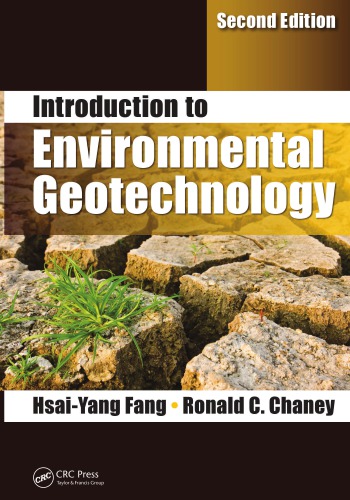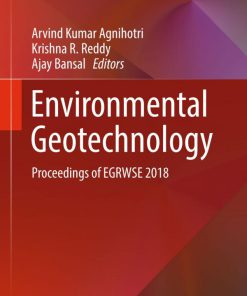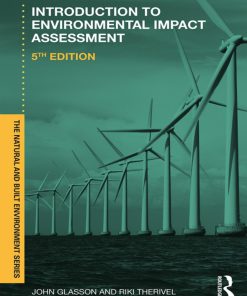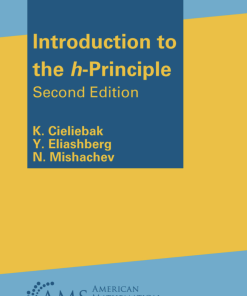Introduction to Environmental Geotechnology 2nd Edition by Ronald Chaney, Hsai Yang Fang 1439837313 9781439837313
$50.00 Original price was: $50.00.$25.00Current price is: $25.00.
Introduction to Environmental Geotechnology 2nd Edition by Ronald C. Chaney, Hsai-Yang Fang – Ebook PDF Instant Download/DeliveryISBN: 1439837313, 9781439837313
Full download Introduction to Environmental Geotechnology 2nd Edition after payment.

Product details:
ISBN-10 : 1439837313
ISBN-13 : 9781439837313
Author: Ronald C. Chaney, Hsai-Yang Fang
This new edition of a bestseller presents updated technology advances that have occurred since publication of the first edition. It increases the utility and scope of the content through numerous case studies and examples and an entirely new set of problems and solutions. The book also has an accompanying instructor’s guide and presents rubrics by which instructors can increase student learning and evaluate student outcomes, chapter by chapter. The book focuses on the increasing importance of water resources and energy in the broader context of environmental sustainability. It’s interdisciplinary coverage includes soil science, physical chemistry, mineralogy, geology, ground pollution, and more.
Introduction to Environmental Geotechnology 2nd Table of contents:
Chapter 1 Introduction
1.1 Introduction
1.2 Development of Environmental Geotechnology
1.2.1 General Discussion
1.2.2 Population Growth and Rising Living Standards
1.3 Aims of Environmental Geotechnology
1.4 Environmental Cycles and Their Interaction with GeotcSpecific Gravityehnology
1.4.1 General Discussion
1.4.2 The Natural Environment
1.4.2.1 The Atmosphere
1.4.2.2 The Biosphere
1.4.2.3 The Hydrosphere
1.4.2.4 The Lithosphere
1.4.2.5 The Geomicrobiosphere
1.4.3 The Cycles of Nature
1.4.3.1 Oxygen Cycle
1.4.3.2 Nitrogen Cycle
1.4.3.3 Carbon Cycle
1.4.4 Water Stability in Natural Environmental Systems
1.5 Man-Made Environment
1.5.1 General Discussion
1.5.2 Solid and Liquid Wastes
1.5.3 Solid Wastes (Urban Refuse)
1.5.4 Waste Rubber Tires
1.5.5 Petroleum-Contaminated Soil
1.6 Acid Rain and Acid Drainage
1.6.1 Acid Rain (Acid Deposition)
1.6.2 Acid Mine Drainage
1.7 Environmental Geotechnical Problems
1.7.1 Arid Lands and Desert
1.7.2 Marginal Lands (Wetlands)
1.7.3 Coastal Margins
1.7.4 Soil Erosion
1.8 Pollution Processes and Soil-Pollution Interaction
1.8.1 General Discussion
1.8.2 Ground Pollution Sources or Routes
1.8.3 Pollution Process Mechanisms
1.9 Energy–Environment–Disaster Cycle
1.9.1 General Discussion
1.9.2 Environmental Geotechnical Problems
1.10 Methods for Analysis of Environmental Geotechnical Problems
1.10.1 General Discussion
1.10.2 Review of Current Soil Mechanics Concepts
1.10.3 Proposed Approaches or Methods for Evaluation of Soil Behavior
1.10.3.1 General Discussion
1.10.3.2 Instruction
1.10.3.3 Laboratory Testing
1.10.3.4 Data Interpretation and Analysis
1.11 Scope and Organization of the Text
1.12 Summary
Problems
Chapter 2 Particle-Energy-Field Theory and Its Applications
2.1 Introduction
2.2 The Concept of Particle-Energy-Field Theory
2.2.1 Fundamentals
2.2.2 Assumptions
2.2.3 Elementary Particles
2.2.4 Particle Systems
2.3 Energy, Energy Field, and Particle Energy Field
2.3.1 Energies between Particles
2.3.1.1 Bonding Behavior between Particles
2.3.1.2 Attractive and Repulsive Forces
2.3.2 Energy and Energy Fields
2.3.3 Particle Force Field
2.3.4 Energy Fields and Environments
2.4 The States of Aggregation of Idealized Particles
2.4.1 General Discussion
2.4.2 Types of Bonds and Energy Ranges
2.4.3 Volume Relationships for Idealized Particles
2.5 Crystal—A True Solid
2.5.1 General Discussion
2.5.2 Crystal Symmetry
2.5.3 The Crystal Systems
2.5.4 Crystal Classes
2.5.5 Crystal Lattices
2.6 Granular Particles and Their Packing Characteristics
2.6.1 General Discussion
2.6.2 Granular Particle Measurement
2.6.2.1 Size Measurement
2.6.2.2 Shape Measurement
2.6.3 Packing Characteristics of Granular Materials
2.6.4 Interparticle Characteristics and Their Primary Structure
2.6.4.1 The Laws of Granulometry
2.6.4.2 Interparticle Forces
2.6.5 Particle Packing Systems
2.6.5.1 Uniform Packings
2.6.5.2 Polygonal Shapes
2.6.5.3 Binary Systems
2.6.5.4 Ternary Systems
2.6.5.5 Continuous Gradings
2.7 Chemical Fundamentals
2.8 Phenomena of Solid–Liquid–Gas at Interface
2.8.1 Single-Phase Interface
2.8.2 Two-Phase Interface
2.8.3 Multiphase Interface
2.9 Particle Behavior Under Load-Mechanical Energy Field
2.9.1 General Discussion
2.9.2 Load–Deformation Process
2.9.3 Particle Dynamics
2.10 Multimedia Energy Field
2.10.1 General Discussion
2.10.2 Thermal Energy Field
2.10.3 Electric and Magnetic Energy Fields
2.10.4 Radiation Energy Field
2.11 Justification for Application to Geotechnology
2.12 Summary
Problems
Chapter 3 Nature of Soil and Environment
3.1 Soil as a Natural Genetic System
3.2 Soil as a Polydisperse System
3.2.1 Characteristics of the Solid Phase
3.2.2 Characteristics of the Liquid Phase
3.2.3 Characteristics of Soil–Air Interface
3.2.4 Characteristics of Soil at In Situ Condition
3.3 Soil Texture, Strata, Horizons, and Profiles
3.3.1 Soil Strata and Texture
3.3.2 Horizons and Profile
3.3.3 Podzol Soil Profiles
3.3.4 PCA Simplified Soil Profile and Horizons System
3.3.4.1 General Discussion
3.3.4.2 Horizons
3.4 Identification and Classification Systems of Soils
3.4.1 General Discussion
3.4.2 Unified Soil Classification System (ASTM D2487)
3.4.3 AASHTO Soil Classification System (AASHTO M145-88)
3.4.4 Other Soil Classification Systems
3.5 USDA Soil Classification System
3.5.1 General Discussion
3.5.2 Orders—Zonal, Intrazonal, and Azonal
3.5.3 Great Soil Groups and Soil Series
3.5.3.1 Great Soil Group
3.5.3.2 Soil Series
3.5.4 Soil Taxonomy
3.6 Chemical Composition of Natural Soil and Clay Fraction
3.6.1 General Discussion
3.6.2 General Chemistry of the Soil
3.6.3 Soil Organic Matter
3.6.4 Silica/Sesquioxide Ratio (SSR) of Clay Fraction
3.7 Granular Soils (Cobble, Boulder, Gravel, Sand, and Silt)
3.7.1 General Discussion
3.7.2 Aggregates
3.7.3 Sand and Gravel
3.7.4 Silt (0.02–0.002 mm)
3.8 Identification and Characterization of Contaminated Soils
3.8.1 General Discussion
3.8.2 Visual Identification of Contaminated Soils
3.8.3 Color of Ground Soil and Water
3.8.3.1 Color of Ground Soil
3.8.3.2 Color of Water and Characteristics of Water Bubbles
3.8.4 Odors in the Environments
3.8.4.1 General Discussion
3.8.4.2 Odor of Natural or By-Product Gases
3.8.4.3 Odor of Soil and Water
3.8.5 Cracking Patterns of Ground Soil
3.8.6 Properties Employed in Characterization of Contaminated Soil
3.9 Classification of Contaminated Soils
3.9.1 Basic Concept
3.9.2 Sensitivity of Soil to Environment
3.9.3 Pollution Sensitivity Index (PSI)
3.10 Dust: Microscopic Debris
3.10.1 General Discussion
3.10.2 Characteristics of Dust
3.10.3 Dust in the Environment
3.11 Suspension: Dust in the Water
3.11.1 Characteristics of Suspension
3.11.2 Suspension in the Environment
3.12 Summary
Problems
Chapter 4 Soil Technology
4.1 Introduction
4.2 Clay Mineralogy
4.2.1 General Discussion
4.2.2 Mineralogical Data Requirements
4.3 Structural Units of Soils
4.3.1 General Discussion
4.3.2 Clay Mineral Structures
4.3.3 Identification and Determination of Clay Minerals
4.3.3.1 X-Ray Diffraction (XRD) Analysis
4.3.3.2 Differential Thermal Analysis (DTA)
4.3.3.3 Scanning Electron Microscope (SEM)
4.4 Size and Shape Measurement of Soil
4.4.1 Effective Size and Uniformity Coefficient
4.4.2 Size and Shape Measurement for Granular Soils
4.4.3 Surface Area for Fine-Grained Soil
4.5 Particle Bonds, Bond Energies, and Linkages
4.5.1 Particle Bonds
4.5.2 Bond Energies
4.5.3 Linkage between Particles
4.6 Interparticle Energies or Forces
4.6.1 Dipole Moment and Orientation Effect
4.6.2 Attractive Energy or Force
4.6.2.1 Norrish Equation (1954)
4.6.2.2 MacEwan Equation (1954)
4.6.2.3 Jordine et al. (1962) and Jordine Equation (1963)
4.6.3 Repulsive Energy or Force
4.6.3.1 Pauling Equation (1945, 1960)
4.6.3.2 Van Olphen Equation (1954)
4.7 Particle Arrangement and Clay Structures
4.7.1 Particle Arrangement and Structures
4.7.2 Isomorphous Substitution
4.8 Ion-Exchange Reaction and Ion-Exchange Capacity
4.8.1 General Discussion
4.8.2 Characteristics and Mechanisms of Ion-Exchange Reaction
4.8.2.1 General Discussion
4.8.2.2 Ion-Exchange Reaction Mechanisms
4.8.2.3 Ion-Exchange Capacity
4.8.3 Factors Affecting IEC
4.8.3.1 Particle Size
4.8.3.2 Specific Surface Area
4.8.3.3 Temperature or Heat
4.8.3.4 Effect of Size of Ions
4.8.3.5 Correlation with Other Parameters
4.8.4 Anion Exchange
4.8.5 Ion-Exchange Reaction in Contaminated Soil–Water Systems
4.8.5.1 General Discussion
4.8.5.2 Ion-Exchange Reaction between Solids
4.8.5.3 Ion-Exchange Reaction between Phases
4.9 The Clay–Water–Electrolyte System
4.9.1 Characteristics of Diffuse Double-Layer
4.9.2 The Clay Micelle and Its Structure
4.9.3 Free Water and Environmental Water
4.9.3.1 Adsorbed Water
4.9.3.2 Osmotic Water
4.9.3.3 Hydration Water and Hydratation Water
4.9.3.4 Oriented Water
4.10 Characteristics and Structures of Some Typical Clay Minerals
4.10.1 General Discussion
4.10.2 Kaolin, Montmorillonite, and Illite Groups
4.10.2.1 Kaolinite Group
4.10.2.2 Montmorillonite Group
4.10.2.3 Illite Group
4.10.3 Chlorites and Halloysites
4.10.3.1 Chlorites
4.10.3.2 Halloysites
4.10.4 Geotechnical Properties of Clay Minerals
4.11 Hydrophilic and Hydrophobic Soils
4.11.1 General Discussion
4.11.2 The Changing Mechanisms between Hydrophobic–Hydrophilic Conditions
4.11.3 Characteristics of Hydrophobic and Hydrophilic Soils
4.12 Homoionic Modifications (Pure Soil)
4.12.1 General Discussion
4.12.2 Method for Preparation of Homoionic Soil Samples
4.12.3 Typical Homoionic Modification Data
4.13 The Man-Made Soil
4.13.1 General Discussion
4.13.2 The Concept and Approach of Man-Made Soil
4.14 Summary
Problems
Chapter 5 Soil–Water–Air Interaction in the Environment
5.1 Introduction
5.1.1 General Discussion
5.1.2 Soil Moisture Terminology
5.1.2.1 Suspensions
5.1.2.2 Gravitational Water
5.1.2.3 Capillary Range
5.1.2.4 Hygroscopic Range and Ignition Point
5.1.3 Soil–Water System and Its Measurable Parameters
5.2 Nature of Water
5.2.1 Molecular Dimensions and Bulk Properties
5.2.2 Packing Characteristics
5.2.3 Chemical Composition of Water
5.3 Properties of Water and Water Substances
5.3.1 Density, Unit Weight, and Specific Gravity of Water
5.3.1.1 Density and Unit Weight
5.3.1.2 Specific Gravity
5.3.2 Surface Tension
5.3.3 Viscosity of Water and Other Pore Fluids
5.3.3.1 Absolute or Dynamic Viscosity
5.3.3.2 Kinematic Viscosity
5.3.4 Dielectric Constant of Water
5.4 Solutions, Compounds, Mixtures, and Electrolytes
5.4.1 Solutions, Solvents, and Solute
5.4.1.1 Solutions
5.4.1.2 Solvent and Solute
5.4.2 Compounds and Mixtures
5.4.3 Electrolytes
5.4.4 Acidity and pH Value
5.5 Types and Sources of Water
5.5.1 Groundwater
5.5.2 River and Lake Waters
5.5.3 Hard, Soft, Acidic, and Alkali Waters
5.5.3.1 Hard and Soft Waters
5.5.3.2 Acidic and Alkali (Basic) Waters
5.6 Electrochemical Characteristics of the Soil–Water System
5.6.1 Surface Electrochemical Characteristics of Soil
5.6.2 Flow Routes Relating to Soil–Water Interaction
5.6.2.1 Flow Path—Wetting Process
5.6.2.2 Flow Path—Drying Process
5.6.3 Soil–Water Interaction in Various Energy Fields
5.7 Soil–Water Interaction in the Thermal Energy Field
5.7.1 Heat of Wetting
5.7.2 Water Intake Ability
5.7.3 Kinetic Dispersive Force
5.8 Soil–Water Interaction in the Electric Energy Field
5.8.1 Polarization
5.8.2 Proton Migration
5.9 Geomorphic Process (Aging Process)
5.9.1 Concept of Geomorphic Process
5.9.2 Geomorphic Process Mechanisms
5.9.2.1 Mechanical Causes and Short-Term Process
5.9.2.2 Chemical and Physicochemical Processes
5.9.2.3 Geomicrobiological Process
5.9.2.4 Soil-Forming Process
5.10 Corrosion Process
5.10.1 General Discussion
5.10.2 Corrosion Causes, Types, and Protection
5.10.2.1 General Discussion
5.10.2.2 Corrosion Causes
5.10.2.3 Bacteria Corrosion
5.10.2.4 Corrosion Protection and Example
5.11 Effect of Bacteria on Behavior of the Soil–Water System
5.11.1 Characteristics of Bacteria
5.11.2 Soil–Water–Bacteria Interaction
5.12 Sensitivity of Soil to the Environment
5.12.1 General Discussion
5.12.2 Sensitivity of Soil to Load
5.12.3 Sensitivity of Soil to Pore Fluid
5.13 Soil–Water–Air Interaction
5.13.1 Behavior of Air in Soil–Water System
5.13.2 Soil–Water–Vapor Interaction
5.14 Summary
Problems
Chapter 6 Shrinkage, Swelling, and Cracking Characteristics of Soil
6.1 Introduction
6.2 Shrinkage Characteristics
6.2.1 Characteristics of Shrinkage of Soil
6.2.2 Factors Affecting Shrinkage of Soil
6.3 Swelling Characteristics
6.3.1 Swelling Mechanism
6.3.2 Swelling Measurements
6.3.3 Factors Affecting Swelling Characteristics of Soil
6.4 Sorption Characteristics
6.4.1 Water Sorption
6.4.2 Absorption and Degree of Saturation
6.4.3 Absorption of Organic Molecules
6.5 Adsorption Phenomena
6.5.1 Types of Adsorption
6.5.1.1 Physical Adsorption
6.5.1.2 Chemical or Activated Adsorption
6.5.2 Adsorption Mechanism
6.5.3 Adsorption Measurements
6.5.3.1 Absorption Relating to the FME
6.5.3.2 Adsorption Relating to the CME
6.5.4 Adsorption Characteristics in the Environment
6.5.4.1 Adsorption Characteristics
6.5.4.2 Polymer Adsorption
6.5.4.3 Adsorption of Hazardous Substances
6.5.4.4 Adsorption and Stabilizing Materials
6.6 Cracking Phenomena and Mechanisms
6.6.1 Soil Cracking Phenomena
6.6.1.1 General Discussion
6.6.1.2 Soil Cracking Types
6.6.2 Cracking Mechanisms
6.6.2.1 Cracking–Fracture Phenomena and Relationships
6.6.2.2 Cracking–Moisture Relationship
6.6.3 Cracking Pattern and Measurements
6.6.3.1 Cracking Pattern Measurement Procedure (Lehigh Method)
6.6.3.2 Internal Soil Cracking Measurement
6.6.3.3 Cracking Behavior of Contaminated Soils
6.6.3.4 Soil Structures Relating to Cracking Patterns
6.7 Tensile Characteristics of Soil
6.7.1 Introduction
6.7.2 Mechanism of Tensile Strength of Soil
6.7.3 Measurement of Tensile Strength of Soil
6.7.4 Tensile Strength Relating to Other Soil Constants
6.7.4.1 Atterberg Limits and Density
6.7.4.2 Activity and Toughness Index
6.7.4.3 Compressive Strength
6.7.4.4 Cohesion and Friction Angle
6.7.4.5 Effect of Exchangeable Ions
6.7.4.6 Soil Classification Based on Tensile Strength
6.8 Fracture Characteristics of Soil
6.8.1 Introduction
6.8.2 Application of Linear Elastic Fracture Mechanics (LEFM)
6.8.3 Laboratory Fracture Tests on Soils
6.8.3.1 Preparation of Test Specimen
6.8.3.2 Gc and Kc Measurements and Computations
6.8.3.3 Fracture Load Tests on Stabilized and Contaminated Soils
6.8.4 Applications from Cracking and Fracture Data
6.8.4.1 Use as a Guideline in Ground Improvement Program
6.8.4.2 Cracking Patterns Used for Identification and Characterization of Soil
6.8.4.3 Internal Cracks Used to Evaluate the Soil Disturbance
6.9 Summary
Problems
Chapter 7 Hydraulic Conductivity and Mass Transport Phenomena
7.1 Introduction
7.2 Capillarity
7.2.1 General Discussion
7.2.2 Height and Rate of Capillary Rise
7.2.2.1 Height of Capillary Rise
7.2.2.2 Rate of Capillary Rise
7.2.3 Factors Affecting Capillary Rise
7.2.3.1 Effect of Time and Soil Particle Size
7.2.3.2 Effect of Moisture Content and Types of Pore Fluids
7.2.3.3 Effect of Temperature
7.2.4 Capillary Measurements
7.2.4.1 General Discussion
7.2.4.2 Typical Test Results and Comments
7.3 Hydraulic Conductivity
7.3.1 Darcy’s Law
7.3.2 Hydraulic Head and Energy
7.3.3 Hydraulic Conductivity Equations
7.3.3.1 Theoretical Relationships
7.3.3.2 Empirical Relationships
7.3.4 Hydraulic Conductivity Measurements
7.3.5 Factors Affecting Conductivity Results
7.3.5.1 General Discussions
7.3.5.2 Hydraulic Conductivity of Contaminated Soil
7.3.5.3 Triaxial-Permeameter for Contaminated Pore Fluid
7.4 Infiltration, Percolation, and Retention
7.4.1 Characteristics of Infiltration
7.4.1.1 General Discussion
7.4.1.2 Infiltration Rate or Capacity
7.4.2 Infiltration of Water through a Pavement Surface
7.4.2.1 Infiltration of Water through PCC Pavement
7.4.2.2 Infiltration of Water through Base Course
7.4.2.3 Infiltration of Water through Both Rigid and Flexible Pavement
7.4.3 Percolation and Retention
7.5 Mass Transport Phenomena in Moist Fine-Grained Soils
7.5.1 Creeping Flow
7.5.2 Nature of Pore Fluid in Soil
7.5.3 Coupled Flow
7.5.3.1 General Discussion
7.5.3.2 Soil Conductivity Measurements
7.6 Osmosis and Reverse Osmosis Phenomena
7.6.1 Osmotic Phenomena
7.6.1.1 General Discussion
7.6.1.2 Osmotic Membranes and Osmotic Pressures
7.6.2 Osmotic Pressure in Soils
7.6.2.1 Osmotic Flow in Soils
7.6.2.2 Osmotic Repulsive Pressure in Soils
7.6.3 Reverse Osmosis Phenomena
7.7 Soil–Water Suction and Diffusivity
7.7.1 Soil–Water Suction
7.7.2 Soil–Water Diffusivity
7.7.2.1 General Discussion
7.7.2.2 Field Measurements
7.8 Moisture Migration
7.8.1 Characteristics of Moisture Migration
7.8.2 Limits of Moisture Migration
7.8.3 Factors Affecting Moisture Migration in Soils
7.8.3.1 Possible Modes
7.8.3.2 Porosity and Specific Surface Area
7.8.3.3 Soil Structure
7.9 Diffusion Phenomena
7.9.1 General Discussion
7.9.2 Diffusion Phenomena in Soil–Water System
7.10 Water Movement in Vadose Zone
7.11 Summary
Problems
Chapter 8 Thermal Properties of Soils
8.1 Introduction
8.2 Characteristics of Heat and Heat Sources
8.2.1 Characteristics of Heat
8.2.2 Heat Sources
8.2.3 Heat Exchange near the Ground Surface
8.3 Heat Transfer Process and Measurable Thermal Parameters
8.3.1 Heat Transfer Process
8.3.1.1 Conduction
8.3.1.2 Convection
8.3.1.3 Radiation Process
8.3.2 Measurable Thermal Parameters
8.3.2.1 General Discussion
8.3.2.2 Temperature and Heat
8.3.2.3 Heat Capacity and Specific Heat
8.3.2.4 Diffusivity
8.4 Soil–Heat Interaction
8.4.1 Mechanism of Soil–Heat Interaction
8.4.2 Soil Thermal Storage Capacity
8.5 Thermal Conductivity and Resistivity of Soil
8.5.1 Thermal Conductivity
8.5.2 Thermal Resistivity
8.5.2.1 General Discussion
8.5.2.2 Practical Aspects of Thermal Resistivity
8.5.2.3 Effects of Moisture Content and Density
8.6 Effects of Heat or Temperature on Soil Behavior
8.6.1 General Discussion
8.6.2 Characteristics of Soil–Heat System
8.6.3 Effect of Soil Behavior at Low-Temperature Range
8.6.3.1 Soil Constants
8.6.3.2 Unit Weight–Moisture Relationship of Soil
8.6.3.3 Compressibility
8.6.3.4 Porewater Pressures
8.6.3.5 Modulus and Shear Strength
8.6.4 Effect of Soil Behavior at Medium-Temperature Range
8.6.5 Fusion
8.7 Frozen and Thawing Soils
8.7.1 Identification and Description of Ice in Soil
8.7.2 Frost Depth (Penetration) and Heave
8.7.2.1 Analytical Approaches
8.7.2.2 In Situ Measurement
8.7.2.3 Frost Heave and Rate of Heave
8.7.2.4 Freezing Index
8.7.3 Environmental Geotechnical Problems of Frozen Soil
8.7.3.1 Geotechnical Properties and Foundation Problems
8.7.3.2 De-Icing Problems
8.7.4 Characteristics of Thawing Soil
8.7.4.1 General Discussion
8.7.4.2 Properties of Thawing Soil
8.8 Characteristics of Snow
8.8.1 General Discussion
8.8.2 Properties and Problems of Snow
8.9 Summary
Problems
Chapter 9 Electrical Properties of Soils
9.1 Introduction
9.2 Characteristics of Particles and Electricity
9.2.1 General Discussion
9.2.2 Electric Field and Electric Charge
9.3 Measurable Parameters in Soil–Water–Electricity System
9.3.1 General Discussion
9.3.2 Electromotive Force and Resistance
9.3.2.1 Electromotive Force
9.3.2.2 Resistance
9.3.3 Conductance, Capacitor, and Capacitance
9.3.3.1 Conductance
9.3.3.2 Capacitor
9.3.3.3 Capacitance
9.4 Fundamentals of Soil–Electrochemistry
9.4.1 General Discussion
9.4.2 Soil–Electrochemical Interaction and Its Measurement
9.4.2.1 Evapotranspiration
9.4.2.2 Leaching
9.4.3 Electrode and Cell
9.4.4 Electrolysis
9.4.4.1 Faraday’s Laws
9.4.4.2 Faraday Unit
9.5 Electrolytes and Electrical Reactions
9.5.1 Characteristics of Electrolytes
9.5.1.1 Salts and Base
9.5.1.2 Natural Electrolytes—Acid Rain and Acid Drainage
9.5.2 Electrode and Redox Reactions
9.5.2.1 Electrode Reaction
9.5.2.2 Redox Reaction
9.5.2.3 Redox Potential
9.5.3 Characteristics of Eh and pe and Their Relationship
9.6 Electric Properties of Soil, Water, and Rock (When Additional Electricity Is Applied)
9.6.1 Mechanism of Soil–Electricity Interaction
9.6.2 Properties Measured by Electric Current and Voltage
9.6.2.1 Soil–Water Properties
9.6.2.2 Locating Leak Sources of Geomembrane Liners
9.6.2.3 Soil Fabric Replication Using Formation Factor
9.6.3 Electric Charge and Surface Charge Density
9.6.3.1 Characteristics of Electric Charge in Soil–Water System
9.6.3.2 Effect of Electric Surface Density on Soil–Water System
9.6.4 Electric Resistivity of Soil, Rock, and Water
9.6.4.1 General Discussion
9.6.4.2 Soil and Rock
9.6.4.3 Water Quality Measured by Electric Resistivity/Conductance
9.6.5 Electrical Properties of Contaminated Soil
9.7 Dielectric Constant of Soil–Water System
9.7.1 Characteristics of the Dielectric Constant
9.7.2 Dielectric Constant of Substance
9.7.2.1 General Discussion
9.7.2.2 Dielectric Constant Measurement
9.7.2.3 Electrical Dispersion Measurement
9.7.3 Dielectric Constant of Water and Other Pore Fluids
9.7.3.1 Dielectric Constant of Water
9.7.3.2 Dielectric Constant versus pH Value
9.7.4 Effect of Dielectric Constant on Soil Behavior
9.7.4.1 Soil Constants
9.7.4.2 Dielectric Constant Related to CEC and Zeta Potential
9.7.4.3 Effect of Dielectric Constant on Conductivity and Compressibility
9.7.4.4 Effect of Dielectric Constant on Swelling
9.8 Electric Conductivity and Electrokinetic Phenomena
9.8.1 General Discussion
9.8.2 Assumptions and Equation of Helmholtz–Smoluchowski Theory
9.8.3 Discussions of Helmholtz–Smoluchowski Theory
9.8.3.1 Limitations of Helmholtz–Smoluchowski Theory
9.8.3.2 Modifications and the Gouy–Chapman Theory
9.8.4 Electric-Double-Layer Thickness and Zeta Potentials
9.8.4.1 Electric-Double-Layer Thickness
9.8.4.2 Zeta (ζ) Potential
9.9 Ground Improvement by Electrokinetic Process
9.9.1 Characteristics and Mechanisms
9.9.2 Dewatering and Soil Stabilization
9.9.3 Factors Affecting the Electrokinetic Process
9.10 Soil Decontamination by Electrokinetic Process
9.10.1 General Discussion
9.10.2 Mechanism of Soil Decontamination
9.11 Electrophoresis and Electromigration
9.11.1 General Discussion
9.11.2 Experimental Measurements
9.12 Electrochemical Process
9.12.1 Fundamentals of Electrochemical Process
9.12.2 U.S. Bureau of Reclamation (USBR) Method
9.12.2.1 Approaches
9.12.2.2 Laboratory Condition: Computation of Osmotic Permeability and Specific Resistance
9.13 Multienergy Effect on Soil–Water System
9.13.1 General Discussion
9.13.2 Electroviscous Effect
9.13.3 Thermoelectric Effect
9.13.3.1 General Discussion
9.13.3.2 Laboratory Experiments
9.13.4 Electromagnetic Effect
9.13.4.1 General Discussion
9.13.4.2 Characteristics of Electromagnetic Force
9.13.4.3 Laboratory Experiments
9.14 Summary
Problems
Chapter 10 Radiation Effects on Water, Soil, and Rock
10.1 Introduction
10.1.1 General Discussion
10.1.2 Review of Basic Nuclear Physics and Chemistry
10.2 Characteristics of Radioactivity
10.2.1 Radioactive Decay
10.2.2 Half-Life, Mean Lifetime, and Activity
10.2.3 Units of Radioactivity
10.2.3.1 Curie (Ci)
10.2.3.2 Becquerel (Bq)
10.2.3.3 Atomic Mass Unit (amu, AMU, u)
10.3 Radioactive Decay Process
10.3.1 General Discussion
10.3.2 Conservation Laws and Radioactive Decay Process
10.3.2.1 Conservation Laws in Radioactive Decay
10.3.2.2 Radioactive Decay Process
10.3.3 Energies of Radiation
10.4 Uranium and Radium Interaction with Environment
10.4.1 Uranium and Radium
10.4.1.1 Uranium (U)
10.4.1.2 Radium (Ra)
10.4.2 Interrelationship among Uranium, Radium, and Radon Gas
10.5 The Noble Gas Family
10.5.1 Characteristics of Noble Gases
10.5.2 Radon and Radon Family
10.6 Environmental Geotechnical Aspects of Radiation
10.6.1 General Discussion
10.6.2 Water–Radiation Interaction
10.6.3 Rock/Soil–Radiation Interactions
10.6.3.1 Rock
10.6.3.2 Soil
10.7 Radioactive and Toxic Radon Gas
10.7.1 Nature of Radon Gas
10.7.1.1 General Discussion
10.7.1.2 Radon Gas and Human Health and Environments
10.7.2 Engineering Properties of Radon Gas
10.7.2.1 General Discussion
10.7.3 Radon Emanation in Rock or Minerals
10.7.3.1 General Discussion
10.7.3.2 Giletti and Kulp Approach (1955)
10.7.3.3 α-Recoil Approach (Fleischer and Mogro-Camero, 1978)
10.7.3.4 α-Recoil-Environmental Approach (Fang, 1990)
10.7.4 Interaction Mechanisms between Radon and Environment
10.7.4.1 Interaction Based on Radon’s Molecular Structure
10.7.4.2 Radon Particle Direct Interaction with Water Molecules
10.7.4.3 Interaction through Dust-Suspension
10.8 Radon Mitigation Methods
10.8.1 Radon Mitigation by Passive Approach
10.8.1.1 U.S. EPA/DER Method
10.8.1.2 Discussions—Advantages and Disadvantages
10.8.2 Radon Mitigation by Active Approach
10.8.3 Monitoring Techniques
10.8.3.1 General Discussion
10.8.3.2 Commercially Available Methods (EPA Approved Methods)
10.8.3.3 Radon Measurements in Subsurface Soil Layer
10.8.3.4 Photochemical Method
10.9 Nuclear Waste Disposal
10.9.1 Review of Background
10.9.2 Sources and Types of Nuclear Wastes
10.9.2.1 Basic Sources of Nuclear Wastes
10.9.2.2 High-Level Radioactive Waste (HLRW)
10.9.2.3 Low-Level Radioactive Waste (LLRW)
10.9.3 Management of Nuclear Wastes
10.9.4 Disposal Locations and Disposal Techniques
10.9.4.1 General Discussion
10.9.4.2 Disposal Locations
10.9.4.3 Radioactive Waste Storage
10.9.4.4 Waste Form and Leaking Routes
10.9.4.5 Comments on Existing Waste Sites
10.10 Utilization of Nuclear Energy for Construction Applications
10.10.1 General Discussion
10.10.2 Research Findings and Safety Considerations
10.10.2.1 Research Findings
10.10.2.2 Benefit/Cost Ratio and Safety Considerations
10.11 Other Applications
10.12 Summary
Problems
Chapter 11 Compressibility and Stress–Strain–Time Behavior of Soils
11.1 Introduction
11.2 Soil Compaction (Densification)
11.2.1 General Discussion
11.2.2 Compaction Theories
11.2.2.1 Proctor Theory (1933)
11.2.2.2 Hogentogler Theory (1937a)
11.2.2.3 Lambe Theory (1958)
11.2.2.4 Compaction Theory Based on Particle-Energy-Field Theory
11.2.3 Effect of Organics on Compaction
11.2.4 Effect of Light Weight Nonorganic Material on Compaction
11.2.5 Factors Influencing Compaction Test Results
11.3 Dynamic Consolidation (Dynamic Densification)
11.3.1 General Discussion
11.3.2 Load–Deformation Relationship and Effective Depth
11.3.2.1 Menard and Broise Method (1975)
11.3.2.2 Leonards et al. Modified Method (1980)
11.3.2.3 Lukas Method (1980)
11.3.2.4 Charles et al. Method (1981)
11.3.2.5 Fang–Ellis Method (1983, 1995a)
11.4 Consolidation
11.4.1 General Discussion
11.4.2 Terzaghi Consolidation Theory
11.5 Normally and Overconsolidated Clays
11.5.1 General Discussion
11.5.2 Preconsolidation Pressure and Overconsolidation Ratio
11.5.2.1 Preconsolidation Pressure
11.5.2.2 Overconsolidation Ratio (OCR)
11.5.2.3 Shear Characteristics of Overconsolidated Clay
11.5.3 Factors Affecting Consolidation Test Results
11.5.3.1 Temperature or Heat
11.5.3.2 Pore Fluid
11.5.3.3 Exchangeable Ions
11.6 Prefailure Deformation and Failure Condition of Soil
11.6.1 Prefailure Characteristics of Soil
11.6.2 Relationship between Prefailure and Failure Conditions
11.6.2.1 Prefailure Stage (Point a to b in Figure 11.19)
11.6.2.2 Prefailure Stage-Environmental-Load (Point b to c)
11.7 Stress–Strain–Strength Characteristics of Soil
11.7.1 Failure Criteria
11.7.2 Types of Shear Testing
11.7.2.1 Standard Shear Testing
11.7.2.2 Determination of Undrained Shear Parameters from qu and σt
11.7.3 Factors Affecting Shear Strength
11.7.3.1 Temperature and Electrolyte Concentration
11.7.3.2 Contaminated Pore Fluids
11.7.3.3 Ion-Exchange Reaction
11.7.4 Sensitivity, Creep, and Relaxation of Soil
11.7.4.1 Sensitivity
11.7.4.2 Effect of Time on Soil Behavior
11.7.4.3 Creep Behavior
11.7.4.4 Stress Relaxation
11.8 Residual Shear Strength
11.8.1 Characteristics of Residual Shear Strength
11.8.1.1 General Discussion
11.8.1.2 Methods for Determination of Residual Strength
11.8.2 Residual Strength Data Interpretations
11.8.3 Correlation of Residual Strength to Other Soil Parameters
11.8.3.1 Correlation with Clay Content and Atterberg Limits
11.8.3.2 Correlation with Liquidity Index (LI)
11.8.3.3 Correlation with Applied Normal Stress
11.8.3.4 Correlation with Residual Strength Coefficient (μr)
11.9 Soil Dynamics
11.9.1 Dynamic Shear Modulus and Damping Ratio of Soils
11.9.1.1 Introduction
11.9.1.2 Experimental Results
11.9.2 Dynamic Shear Modulus of Contaminated Soil
11.10 Blasting Dynamics
11.10.1 General Discussion
11.10.2 Blasting Energy and Safe Limits
11.10.2.1 Safe Distance and Particle Acceleration
11.10.2.2 Energy Ratio
11.10.2.3 Particle Velocity and Scaled Distance
11.10.2.4 Fang–Koerner Cracking-Intensity Concept
11.10.2.5 Blasting Safe Limits Criteria
11.11 Summary
Problems
Chapter 12 Environmental Geotechnical Engineering Applications
12.1 Introduction
12.1.1 General Discussion
12.1.2 Environmental Geotechnical Applications
12.1.3 Basic Considerations of Ground Improvement Systems
12.2 Load–Environmental Factor Design Criteria
12.2.1 Load Factor Design Criteria and Approaches
12.2.1.1 Load Factor Design Criteria
12.2.1.2 Load Factor Design Approaches
12.2.2 Environmental–Load Factor Design Criteria
12.2.2.1 General Discussion
12.2.2.2 Environmental Factors
12.2.2.3 Load–Environmental Factor Design Approaches
12.3 Soil–Structure versus Structure–Soil Interactions
12.3.1 General Discussion
12.3.2 Structure–Soil Interaction
12.3.3 Soil–Foundation–Structure Interaction
12.4 Load, Factor of Safety, and Allowable Conditions
12.4.1 Loads and Environmental Loads
12.4.1.1 Loads
12.4.1.2 Environmental Loads
12.4.2 Factor of Safety and Allowable Loads
12.5 Bearing Capacity of Ground Soil
12.5.1 Load–Footing Interaction
12.5.2 Bearing Capacity from Building Codes
12.6 Lateral Earth Pressures
12.6.1 Active and Passive Earth Pressures
12.6.2 Coefficient of Earth Pressure at Rest, K0
12.6.3 K0 for Clay-Like Soil and Sand
12.6.3.1 Clay-Like Soil
12.6.3.2 K0 for Sand
12.7 Friction Forces and Angles between Two Materials
12.7.1 Friction Angle between Soil and Soil
12.7.2 Friction Angle between Soil and Wall
12.8 Pile Foundations
12.8.1 Characteristics of Piles
12.8.1.1 General Discussion
12.8.1.2 Selection of Pile Types
12.8.1.3 Soil–Pile Interaction in the Environment
12.8.1.4 Friction Resistance between Pile and Soil
12.8.2 Environmental Factors Affecting Pile Capacity
12.8.2.1 Fluctuation of Groundwater Table
12.8.2.2 Ground Temperature and Freezing–Thawing Cycles
12.8.2.3 Pollution Intrusion and Corrosion Effects
12.8.2.4 Pile Damage during Driving Process
12.8.3 Field Inspection of Pile Foundations
12.8.4 Special Types of Pile and Their Uses
12.8.4.1 General Discussion
12.8.4.2 Highly Acid-Resistant Piles
12.8.4.3 Piles Used in Special Conditions
12.8.4.4 Piles Made from Waste or By-Products
12.9 Underwater Foundation Problems
12.9.1 Underwater Inspection of Substructures
12.9.2 Maintenance and Repair of Underwater Facilities
12.9.2.1 Prevention
12.9.2.2 Corrosion Protection and Repair Techniques
12.10 Grouting and Injection Processes
12.10.1 General Discussion
12.10.2 Grouting Process and Soil–Grout Interaction
12.10.2.1 Grout and Injection Processes
12.10.2.2 Soil–Grout Interaction
12.10.3 Grout Used for Controlling Hazardous/Toxic Wastes
12.10.3.1 General Discussion
12.10.3.2 Grout System for Control of Hazardous/Toxic Wastes
12.11 Summary
Problems
Chapter 13 Problematic Soils and Rocks
13.1 Introduction
13.2 Shale and Weathered Rocks
13.2.1 General Discussion
13.2.2 Rock-Like and Soil-Like Shales
13.2.3 Engineering Properties of Shales
13.3 Residual Soils
13.3.1 Characteristics of Residual Soils
13.3.2 Engineering Behavior of Residual Soils
13.3.3 Environmental Effects on Residual Soils
13.4 Expansive Clays
13.4.1 General Discussion
13.4.2 Factors’ Effect on Swelling
13.4.3 Identification and Classification of Expansive Clays
13.4.3.1 Single Index Methods
13.4.3.2 Identification Based on Soil Constants
13.4.3.3 Dielectric Dispersion Method
13.4.4 Properties and Problems of Expansive Clay Deposits
13.4.5 Black Cotton Soils
13.5 Organic Soils
13.5.1 Characteristics of Organic Soils
13.5.2 Classification of Organic Soils
13.5.2.1 NRC Classification (1969)
13.5.2.2 ASTM Classification (1972)
13.5.2.3 Louisiana State Classification System (1970)
13.5.3 Engineering Properties of Organic Soils
13.5.3.1 Water Content and Soil Constants
13.5.3.2 Permeability, Compressibility, and Others
13.6 Karst Region (Sinkhole)
13.6.1 General Discussion
13.6.2 Solution Processes and Mechanisms
13.6.3 Sinkhole and Its Interaction with Environment
13.6.4 Remedial Actions for Sinkholes
13.7 Loess (Aeolian Deposits)
13.7.1 Origin and Distribution
13.7.2 Collapsibility Mechanisms and Phenomena
13.7.3 Properties and Foundation Problems
13.8 Dispersive Clays
13.8.1 General Discussion
13.8.2 Identification Procedures
13.8.3 Properties and Foundation Problems
13.9 Laterite Soils
13.9.1 Characteristics of Laterite Soil
13.9.2 Properties and Foundation Problems
13.10 Lacustrine Sediments and Varved Clays
13.10.1 General Discussion
13.10.2 Marls and Tufas
13.10.3 Varved Clays
13.10.3.1 Characteristics of Varved Clays
13.10.3.2 Environmental Factors Affecting Formation of Varved Clays
13.10.3.3 Engineering Properties and Foundation Problems of Varved Clays
13.11 Saline and Alkali Soils
13.11.1 General Discussion
13.11.2 Properties and Foundation Problems
13.12 Bentonite Clays
13.12.1 Characteristics of Bentonite Clays
13.12.2 Properties and Foundation Problems
13.13 Tephra, Coral, and Sea Shells
13.13.1 Tephra (Volcanic Ash and Cinder)
13.13.2 Coral and Sea Shells
13.14 Summary
Problems
Chapter 14 Wetlands, Coastal Margins, and Soil Erosion Problems
14.1 Wetlands
14.1.1 General Discussion
14.1.2 Definitions, Types, and Classifications
14.1.2.1 Definitions
14.1.2.2 Types and Classifications of Wetland Systems
14.1.3 Natural Characteristics of Wetlands
14.1.4 Rice Paddy (Man-Made Wetland)
14.1.5 Environmental Geotechnical Problems of Wetlands
14.1.5.1 Ecological Effects
14.1.5.2 Engineering Difficulties
14.2 Land and Coastal Margins
14.2.1 General Discussion
14.2.2 Land/Coastal Margin Ecosystem
14.2.2.1 General Discussion
14.2.2.2 Land Margin Ecosystyem Research (LMER) Sites
14.2.2.3 Estuarine Characteristics of LMER Sites
14.2.3 Basic Parameters Needed for Evaluation
14.2.3.1 General Discussion
14.2.3.2 Characteristics of Ocean Waves
14.2.3.3 Climatological and Geo-Environmental Conditions along the Coastline
14.2.4 Environmental Geotechnical Problems
14.3 Beaches and Beach Erosion
14.3.1 Characteristics of Beaches and Beach Sand
14.3.1.1 Characteristics of Beaches
14.3.1.2 Characteristics of Beach Sand
14.3.2 Beach Erosion and Pollution Problems
14.4 Saltwater Intrusion, Estuaries, and Greenhouse Effect
14.4.1 General Discussion
14.4.2 Estuaries and Estuarine Systems
14.4.3 Greenhouse Effect on Coastal Environment
14.5 Marine Sediments and Sea Floor Problems
14.5.1 Marine Environments
14.5.2 Properties of Seawater
14.5.3 Engineering Behavior of Marine Sediments
14.5.4 Pollution and Contaminated Marine Sediments
14.5.5 Marine Structures and Slopes
14.5.5.1 Marine Structures
14.5.5.2 Slopes of Submarine Sediments
14.6 Dredging and Dredging Material
14.6.1 General Discussion
14.6.2 Case Studies and Management Techniques
14.7 Soil Erosion
14.7.1 General Discussion
14.7.2 Erosion Causes and Mechanisms
14.8 Water Erosion
14.8.1 Soil Erosion by Water
14.8.1.1 Equation Estimation by Water Erosion
14.8.1.2 Rainfall Factor (R)
14.8.1.3 Soil Erodibility Factor (K)
14.8.1.4 Topographic Factor (LS)
14.8.1.5 Erosion Control Factor (VM)
14.8.2 Factors Affecting Water Erosion
14.9 Wind Erosion
14.9.1 Soil Erosion by Wind
14.9.1.1 Estimation by Wind Erosion
14.9.1.2 Soil Wind Erodibility Factor (I′)
14.9.1.3 Local Wind Erosion Climatic Factor (C′)
14.9.1.4 Other Factors
14.10 Erosion Control in Construction Areas
14.11 Summary
Problems
Chapter 15 Ground Surface Subsidences
15.1 Introduction
15.2 Characteristics and Classifications of Land Subsidence
15.2.1 Characteristics of Land Subsidence
15.2.2 Classification of Ground Subsidence
15.2.2.1 Geotechnical Engineering Classification
15.2.2.2 Genetic Classification
15.3 Mechanisms and Phenomena of Ground Subsidence
15.3.1 Creep and Progressive Failures
15.3.2 Phenomena Associated with Subsidence
15.4 Ground Subsidence due to Natural Causes
15.4.1 Tectonic Movement and Earthquake
15.4.2 Flora and Fauna of the Soil
15.4.3 Flood or Rainstorm
15.5 Dewatering
15.5.1 Phenomena and Mechanism of Dewatering
15.5.2 Stress Distribution during Dewatering Process
15.5.2.1 Unconfined Aquifer
15.5.2.2 Confined Aquifer
15.5.2.3 Effect of Pumping on Clay Strata
15.5.2.4 Storage Coefficient
15.5.3 Ground Subsidence Prediction
15.5.3.1 General Discussion
15.5.3.2 Mechanisms of Subsidence due to Dewatering
15.5.4 Terzaghi and Zeevaert Methods
15.5.4.1 Terzaghi Method (Terzaghi and Peck, 1967)
15.5.4.2 Zeevaert Method (1972)
15.6 Mining Subsidence
15.6.1 General Discussion
15.6.2 Ground Surface Movement
15.6.2.1 Discontinuous Deformation
15.6.2.2 Continuous Deformation
15.6.3 Prediction of Possible Surface Damage
15.6.3.1 General Discussion
15.6.3.2 Empirical Method
15.6.3.3 Profile Function Method
15.6.3.4 Influence Function Method
15.6.3.5 Phenomenological Method
15.6.4 Underground Precaution for Active Mining
15.6.4.1 Safety Pillars
15.6.4.2 Controlled Undermining
15.6.4.3 Stowing
15.6.4.4 Partial Extraction
15.6.4.5 Rapid Undermining
15.6.4.6 Special Mine Geometries
15.6.4.7 Structural Precautions
15.6.5 Abandoned Mines
15.6.5.1 Characteristics of Abandoned Mines
15.6.5.2 Support Methods and Structural Precautions
15.7 Construction Operations
15.7.1 Deep Excavation
15.7.2 Pile Driving Operation
15.7.3 Dynamic Compaction and Blasting
15.7.4 Subsidence Caused by Local Environmental Conditions
15.7.4.1 Underground Openings
15.7.4.2 Rapid Drawdown
15.7.4.3 Hazardous/Toxic Wastes Disposal
15.8 Geoarchaeology and Archaeogeotechnology
15.8.1 General Discussion
15.8.2 Types and Classification of Archaeology
15.8.3 Natural and Man-Made Causes for Damage to Artifacts
15.8.4 Site Survey, Planning, Retrofit, and Land Reclamation
15.9 Summary
Problems
Chapter 16 Slope Stability of Earth Slopes and Landslides
16.1 Introduction
16.2 Causes and Phenomena Associated with LandslideS
16.2.1 Causes of Ground Movement
16.2.2 Prefailure Phenomena Associated with Landslide
16.3 Progressive Failures and Surface Creep
16.3.1 General Discussion
16.3.2 Progressive Failure and Surface Creep
16.4 Slope Stability Analysis Procedures
16.4.1 General Discussion
16.4.2 Limit Equilibrium and Limit Analysis Methods
16.4.2.1 Limit Equilibrium Method
16.4.2.2 Limit Analysis Method
16.4.3 Selection of Strength Parameters and Factor of Safety
16.4.3.1 Selection of Strength Parameters
16.4.3.2 Factor of Safety, Fs
16.4.4 Uncertainties and Probability of Failure
16.5 Effect of Rainfall on Slope Stability
16.5.1 Rainfall and Rainfall Intensity
16.5.2 Soil–Water Interaction Relating to Slope Stability
16.5.2.1 Mechanism Based on Physicochemical Concept
16.5.2.2 Mechanism Based on Ion-Exchange Effect
16.5.2.3 Mechanism Based on Linear Elastic Fracture Mechanics (LEFM) Concept
16.5.2.4 Mechanism Based on Particle-Energy-Field Theory
16.5.3 Depth of Saturated Zone (Wetting Band)
16.5.3.1 Depth of Saturated Zone (No Surface Cracks)
16.5.3.2 Corrections of Wetting Band due to Ground Surface Cracks
16.6 Landslides in Residual Soil and Weathering Rocks
16.6.1 Characteristics of Residual Soil
16.6.2 Case Study
16.6.2.1 Bucaramanga, Colombia
16.6.2.2 Hong Kong Landslides, 1972
16.7 Landslides in Dispersive and Expansive Clay Regions
16.7.1 Dispersive Clay Regions
16.7.2 Expansive Clay Slopes
16.8 Landslides in Overconsolidated Clay Areas
16.8.1 Failure Mechanism in Overconsolidated Clays
16.8.2 Review of Various Failure Mechanisms
16.8.3 Environmental Geotechnical Approach
16.9 Earthquake Trigger-Causing Landslides
16.9.1 Shallow Slope Failure
16.9.2 Deep Slope Failure
16.10 Slope Stability/Landslide Problems in Adverse Environments
16.10.1 Effects of Logging Operations and Tree Roots
16.10.2 Effects of Overcutting or Excavation
16.10.3 Acid Rain and Acid Drainage Effects on Slope Stability
16.10.4 Marine (Underwater) Slope Stability
16.11 Landslide Prevention, Control, and Remedial Actions
16.11.1 General Discussion
16.11.2 Difficult Soil Conditions
16.11.2.1 Residual Soils
16.11.2.2 Loess and Silt
16.11.2.3 Fissured Clays and Shales
16.11.3 Tropical–Earthquake–Urban Environment
16.12 Genetic Diagnosis of Landslide and Infrastructural Actions
16.12.1 General Discussion
16.12.2 Genetic Diagnosis Approach
16.12.3 Infrastructural Actions
16.12.3.1 Root Pile®
16.12.3.2 Bamboo-Lime Composite Pile
16.13 Landslide Zonation and Microzonation
16.13.1 Zonation and Microzonation
16.13.2 Landslide Zonation and Microzonation Map
16.14 Summary
Problems
Chapter 17 Solid/Liquid Waste Control and Utilization of Wastes
17.1 Introduction
17.1.1 General Discussion
17.1.2 Stability of Urban Refuse (Garbage) in the Landfill
17.1.2.1 Stability of Fresh Garbage
17.1.2.2 Stability of Abandoned Landfill Site
17.1.3 Relationship between Solid and Liquid Wastes
17.2 Characteristics of Urban Refuse (Garbage)
17.2.1 Degradable Garbage
17.2.2 Engineering Classification of Garbage
17.2.3 Recycling and Energy Recovery from Wastes
17.2.4 Engineering Problems of Landfill Sites
17.3 Compaction of Landfill
17.3.1 General Discussion
17.3.2 Review of Sanitary Landfill Test Sections
17.3.3 Surface Compaction Process
17.3.4 Deep Compaction on Landfill Sites
17.3.5 Compaction Control
17.4 Slope Stability of Landfill
17.4.1 Slope Characteristic in Landfill Site
17.4.2 Slope Failure Modes
17.4.3 Slope Stability Analysis
17.4.3.1 Current Practice
17.4.3.2 Genetic Diagnosis Approach
17.5 Laboratory Tests on Compacted Garbage
17.5.1 Stress–Strain–Strength Characteristics
17.5.2 Strength Parameters and Bearing Capacity
17.5.3 Hydraulic Conductivity
17.6 Stability of Garbage during Decomposed Stage
17.6.1 Basic Considerations
17.6.2 Decomposition Processes
17.6.3 Settlement Prediction
17.6.4 Types of Polluted Water and Pressures Produced
17.6.4.1 Types of Polluted Water Produced in the Landfill Areas
17.6.4.2 Acidity Exists in Clay–Liner Interface
17.6.4.3 Environmental Pressures Produced from Landfill
17.6.4.4 Conductivity Phenomena between Landfill and Liner
17.7 Basic Considerations for Design of Waste Control System
17.7.1 General Discussion
17.7.2 Assess the Existing Site and Quantify Site Conditions
17.7.3 Develop the Containment/Treatment Program
17.8 Waste Control System Components
17.8.1 Active and Passive Components
17.8.1.1 Active Components
17.8.1.2 Passive Components
17.8.2 Structure of Control System Components
17.8.2.1 Barrier Walls
17.8.2.2 Soil–Bentonite Slurry Wall
17.8.2.3 Cement–Bentonite Slurry Trench Cutoff Walls
17.8.2.4 Composite System Vertical Cutoff Barrier
17.8.2.5 Vibrating-Beam Walls
17.8.3 Top Seals (Caps)
17.8.3.1 Natural Clay Caps
17.8.3.2 Bentonite Clay Caps
17.8.3.3 Synthetic Membrane Caps and Others
17.8.3.4 Other Surface Water Controls
17.8.4 Bottom Seal (Liners)
17.8.4.1 Native Clay Liners
17.8.4.2 Bentonite Clay Liners
17.8.4.3 Geosynthetic Membrane Liners
17.8.5 Double-Composite Liner System
17.8.5.1 Leachate Collection Systems
17.8.5.2 Primary Composite Liner
17.8.5.3 Leak-Detection System
17.8.5.4 Secondary Composite Liner
17.8.5.5 Layer 10: Subgrade (Soil or Rock)
17.9 Factors Affecting the Stability of Waste Control Systems
17.9.1 Chemical and Tree Root Attack on Liners
17.9.2 Leaking from Impervious Ground Soil Layers
17.9.3 Dynamic Load Effects
17.9.4 Effects of Nearby Sinkholes and Others
17.10 Utilization of Wastes for Engineering Purposes
17.10.1 General Discussion
17.10.2 Technology on Recovery and Reuse of Waste Materials
17.10.3 Scrap Waste Rubber Tire
17.10.3.1 General Discussion
17.10.3.2 Current Practice
17.10.3.3 Uses of Scrap Rubber Tire
17.10.4 Other Waste Uses
17.11 Nanotechnology and New Generation Material System
17.11.1 General Discussion
17.11.2 Function of NIP and New Material System
17.12 Summary
Problems
Chapter 18 Arid Lands, Desert, and Antidesertification Measures
18.1 Introduction
18.2 Characteristics of Desert and Desertification
18.2.1 Definition
18.2.2 Desert and Civilization
18.2.3 Social and Economic Impacts
18.2.4 Desert Distribution
18.3 Desert Environments
18.3.1 Climates
18.3.2 Whirling Dust and Long-Distance Dust
18.3.3 Trees, Vegetation, and Animals
18.4 Characteristics of Desert Soils
18.4.1 Profile of Desert Soils
18.4.2 Desert Varnish and Desert Pavement
18.4.2.1 Desert Varnish
18.4.2.2 Desert Pavement
18.4.3 Subsurface Soil Layer
18.4.4 Valley Soils in Desert Region
18.4.5 Floods
18.5 Desert Sand–Heat Interaction
18.5.1 General Discussion
18.5.2 Thermal Resistivity of Desert Sand
18.6 Desert Sand–Wind Interaction
18.6.1 Causes and Types of Wind
18.6.2 Mechanisms of Sand–Wind Interaction
18.7 Characteristics of Sand Dunes
18.7.1 General Discussion
18.7.2 Types and Causes of Sand Dunes
18.7.3 Characteristics of Sand Dune Movement
18.8 Desert Sand–Water Interaction
18.8.1 Characteristics of Water in Desert Region
18.8.2 Surface Water—Lakes and Streams
18.8.3 Underground Water Resources
18.8.4 Water Resources and Conservation Techniques
18.8.4.1 General Discussion
18.8.4.2 Horizontal Wells and Horizontal Drains
18.8.4.3 Underground Rivers or Streams
18.9 Locating Water Supply Source Based on Preferred Planes Concept
18.9.1 General Discussion
18.9.2 The Concept of Preferred Planes
18.9.3 Procedures for Locating the Preferred Planes
18.9.3.1 Determination of Failure Types and Models
18.9.3.2 Superior Index (SI)
18.10 Antidesertification Measures
18.10.1 General Discussion
18.10.2 Prevention of Sand Movement
18.10.3 Bioengineering Stabilization of Sand Dunes
18.10.4 Protection of Lifelines against Drifting Sand
18.11 Summary
People also search for Introduction to Environmental Geotechnology 2nd:
what is intro to environmental science
introduction to environmental geology
introduction to environmental technology
introduction to geospatial technologies pdf
introduction to geospatial technologies 4th edition
Tags: Introduction, Environmental Geotechnology, Ronald Chaney, Hsai Yang Fang
You may also like…
Engineering - Environmental
Environmental Geotechnology Proceedings of EGRWSE 2018 Arvind Kumar Agnihotri
Engineering - Environmental
Uncategorized
Politics & Philosophy - Social Sciences












